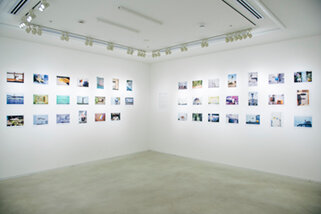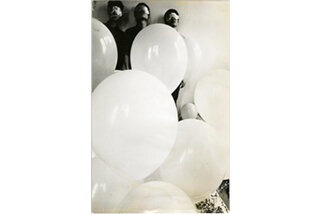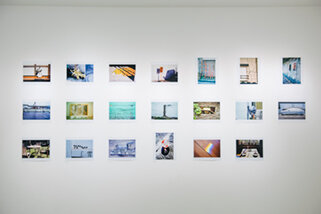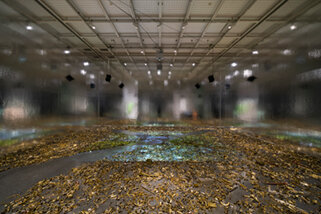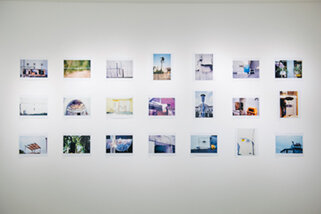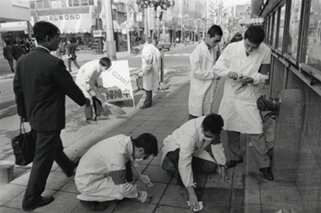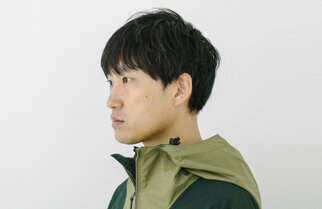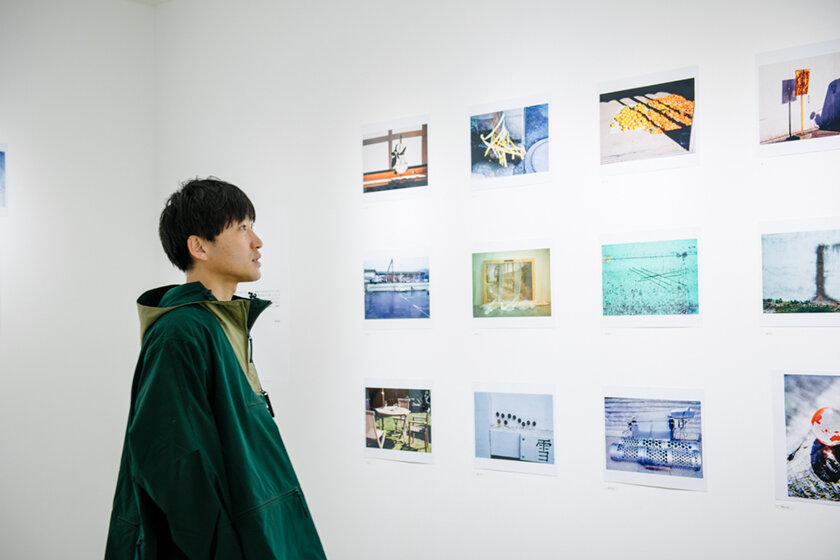


INTERVIEW
145
Shuta Hasunuma × Yuko MohriComposer × Artist
A Picnic in Roppongi Where You Are Free to Spontaneously Join an Unsuspecting “Neighbor”
Spread “poison” around town to help develop immunity for deviating from society
Shuta Hasunuma creates works from a musical standpoint through the Shuta Hasunuma Philharmonic Orchestra collective and various installations, while Yuko Mohri creates installations and sculptures using objects such as household items, instruments, and machine parts. A shared interest in sound and composition has led the two to collaborate in the past. They were both involved in selecting unpublished photos by the late Genpei Akasegawa for an exhibition of his photography at SCAI PIRAMIDE entitled Particles of Art Scattered in Daily Life . We interviewed them on their thoughts on the exhibition and their usual work, particularly concerning the relationship between cities and artists, society in a post-pandemic world, and interpersonal connections.
What arose from encountering Genpei Akasegawa's highly penetrative film rolls
Yuko MohriWe were both involved in the Genpei Akasegawa photo exhibition Particles of Art Scattered in Daily Life, but I think Hasunuma actually met Mr. Akasegawa in person, right?
Genpei Akasegawa Photos Particles of Art Scattered in Daily Life
The exhibition presents roughly 120 unpublished photographs out of those that Genpei Akasegawa left behind in his home. The selection was made by six contemporary artists born in the 1970s and 1980s, the last generation to know about Akasegawa's activities in real time. With Shiseido Gallery Director Keiko Toyoda as guest curator, Zon Ito, Sachiko Kazama, Yasuhiro Suzuki, Yuta Nakamura, Shuta Hasunuma, and Yuko Mohri were in charge of selecting the photographs.
The exhibition ran at SCAI PIRAMIDE from Thursday, January 26 to Saturday, March 25, 2023.
Shuta HasunumaI did. When I was a student, I went to a few talks by Mr. Akasegawa and even asked some questions. Back then, Hi-Red Center wasn't the reason why I attended the talks. I had read one of Mr. Akasegawa's books and found him intriguing.
Hi-Red Center
An artist collective founded in 1963 by Jiro Takamatsu, Genpei Akasegawa, and Natsuyuki Nakanishi. The first kanji character from each of their last names was taken to name the collective, with "Taka" meaning "high," "Aka" meaning "red," and "Naka" meaning "center." They took direct action through performative events in everyday life, such as through The Great Panorama Exhibition (1963) and Dropping Event (1964), as well as Shelter Plan (1964) that invited guests including Nam June Paik to the Imperial Hotel, and Movement to Promote the Cleanup of the Metropolitan Area (1964) that cleaned the streets of Ginza.
Photo: Courtesy of SCAI THE BATHHOUSE
MohriI unfortunately never got the chance to meet him. But as I was looking through Mr. Akasegawa's private photographs for the exhibition, I started feeling like I was being possessed by his spirit. I would see Mr. Akasegawa's wife in a photograph and feel like she was my wife, which was probably uncalled for. [laughs]
HasunumaTotally uncalled for. [laughs] We each got to choose twenty photos from the 40,000 or so unpublished photographs by Mr. Akasegawa. What did you feel during the selection process, Mohri san?
MohriI was able to see Mr. Akasegawa's perspectives on how he saw cities, as well as how the way he lived his life was the same as the way he looked at his work. I talked about being possessed, but his film rolls are just that penetrative. Maybe that's why it seems like the different personalities of the six artists who made the selections naturally come out in the final result. None of the selections seem too eccentric, and feel like they're chosen by "Shuta Hasunuma possessed by Mr. Akasegawa" or "Sachiko Kazama possessed by Mr. Akasegawa," and so on. It was a very interesting experience.
The photos the six chose were relevant to each of their own work
HasunumaIn my case, I started off by thinking about Mr. Akasegawa's words instead of examining each photo and interpreting something from them. Photos weren't the only things he left behind. There were a lot of notes and diaries as well, and I remember he talked a lot about the coincidental nature of things. So in my selection I thought about how I might be able to create my own sense of "coincidence." I had a kind of number generator app made and picked out the photos randomly. That's why I don't really feel like I "chose" them myself. Looking at the ones the others chose in the exhibition, though, the artists' personal sentiments are so strong...almost too strong, you know?
MohriYasuhiro Suzuki even came up with his own titles for the photos he chose.
HasunumaThat wasn't fair. [laughs] But I did think his approach was very considerate of the people coming to see the photos. Oh, and everyone was serious about writing the text displayed next to their selection of photos. They got pretty long.
MohriI figured this might be my only chance to write about Mr. Akasegawa so I think I deliberately wrote more than I normally would.
HasunumaI actually thought I should avoid writing about my own sentiments as much as possible, for some reason. [laughs] But I think as a result, my text shows how different my approach was from everyone else's, so I think it was okay in the end. What about you, Ms. Mohri? How did you make your selection of photos?
MohriFor about two or three months, I spent any spare time I had looking at the 40,000 photos one by one, and picked out about a hundred that caught my attention. Then I whittled them down to twenty. Looking at your selection, Mr. Hasunuma, I thought they kind of felt filtered by atmosphere. Like, a lot of the photos are multilayered, you know?
HasunumaTrue, I think a lot of them capture the phenomenon of a moment instead of a certain situation or scene. At first glance, the composition of Mr. Akasegawa's photos have a beauty about them that makes it hard to believe they're snapshots. I guess that's why coming up with a theme for my selection felt too arbitrary to me. So I decided to use an app as a radical way to choose, but I look at the resulting selection and feel like the photos actually relate to my own form of expression. For example, there's something similar about the way they capture a spontaneous moment instead of using things as objects or connecting to something through an installation.
Shuta Hasunuma's selection of photos
When talking about the element of coincidence in his photography, Akasegawa once stated that if he looked back on all of his works at the time of death, they would seem to have been destined to be that way. Based on this, Hasunuma made his selection with the theme "anti-coincidence." He explores coincidence that is constructed in people's minds and what occurs outside of that.
~ ing
A solo exhibition by Hasunuma held in 2018 at the Shiseido Gallery. It was composed of installations such as one where brass instrument parts left over from the manufacturing process were strewn across the venue floor. The exhibition portrayed the way Hasunuma sees objects.
Photo:Ken Kato
MohriI also found that a lot of the photos I picked featured items that I might find in my own works. Gradually, I think I started looking at the photos with a focus on what to do about the installation view.
Yuko Mohri's selection of photos
In looking at the vast number of Akasegawa's private photos, Mohri felt that certain objects and scenes coaxed her across atmosphere and time, and selected scenes that "subtly appealed" to her. The resulting selection brings out a moment in everyday life that quietly shakes one's emotions.
Moré Moré (Leaky)Series
A two-dimensional installation developed from her previous fieldwork series Moré Moré Tokyo (Leaky Tokyo), which documented how water leakage was dealt with in Tokyo Station. One of the photos Mohri selected features lightbulbs, which appears in her own work.
Moré Moré (Leaky): The Falling Water Given
2015-2017
Photo:© Blaise Adilon / Biennale de Lyon 2017
HasunumaIn the end, each of the six ended up with a selection linked to their own sense of expression.

What new future media needs is a human touch
MohriOne thing I felt working on this exhibition is that I really wish that smartphone culture would have a little less influence. At the moment, I feel like the window to the outside world is typically the window in your smartphone. When I look at Mr. Akasegawa's photos, even the most weathered, dilapidated places are clean and tidy, and I get the sense that someone is taking proper care of them. Just like how an abandoned building will rot away without anyone living in it, cities today lack the ambiance and scrutiny of actual humans, so the scenery is dead. I find that dangerous, and I wish there was a way to bring more life back to the cities.
HasunumaIt's a difficult problem. Personally, I think the format of the smartphone is reaching a critical point. I'm sure smartphones will disappear altogether someday, and people will be making their own scenery in something like a metaverse. Also, the images we usually take on our smartphones--can they really be called "photographs"? When I look at the images Mr. Akasegawa took, I feel that they really are "photographs." The images we take on smartphones may look like photographs, but I think they're more of a record, no more than data.
MohriLike on an external hard drive.
HasunumaExactly. I think we have to accept that those images are data and that 20th century media is virtually defunct in order to move on and create the next thing. Just like you mentioned, Ms. Mohri, the next new medium should definitely include the kind of human touch, the warmth, and tangible sensation found in Mr. Akasegawa's photos. I also hope it will be something that makes you think humans are good. In that sense, it would be nice if art doesn't give in to capitalism and function more in everyday life and in society.
Artists thinking about environmental problems: what they can do right now
HasunumaOn one hand I want art to function that way, but at the same time, I don't personally think I can do anything for society at the moment. Particularly when up against environmental problems, I often wonder if there's anything an artist can do to have direct impact.
MohriEnvironmental problems are just too big. Of course, you have new realizations on a regular basis but there's also despair at the same time, that it's too late. Though of course, I can do what I can on an individual level, and sometimes my thoughts on the environment give me inspiration for making art.
HasunumaPrompting direct action is quite difficult, and there's not much you can do asides from appealing to companies and society. But I do think it's really important to communicate what you think is good or isn't good from an individual standpoint.
MohriI agree. I sometimes go to garbage collection sites as kind of a social studies field trip, and it shocks me to see the sheer amount of garbage. At this rate, all of Tokyo's ocean area will be gone within the next fifty years, reclaimed via landfill. So what can I do about that? I don't have the authority to comment as an individual with any kind of responsibility, but I figure I can share my perspectives based on what I've seen for myself, or make art to communicate those views.
HasunumaBoth as an artist and as a person living in today's world, I think we simply cannot afford to back down from environmental problems and it's something we have to deal with immediately. Besides, as someone just about to turn forty years old, a part of me thinks that the predicament that today's society is in is inherited filth from the 20th century.
MohriWait, what?! I know this is going off topic, but...you're still not forty?
HasunumaI'm thirty-nine, just barely hanging on to my thirties. [laughs] I've been alive longer than today's children, so there are definitely benefits and conveniences that I enjoyed before I knew better, and I emit CO2 just by living as it is. I think it's on us to figure out how to cope with this risk we have created .This has nothing to do with being an artist, but just on an individual level. I've lived in the modern world for almost forty years, after all.
MohriIn terms of the environment, it really comes down to what you feel and do as an individual. Maybe that's not really what you would call direct action, though, and I haven't quite figured it out myself yet.
HasunumaSpeaking of which, you know how Hi-Red Center comprised of Mr. Akasegawa, Mr. Jiro Takamatsu, and Mr. Natsuyuki Nakanishi did a performance called the "Movement to Promote the Cleanup of the Metropolitan Area" where they picked up trash and cleaned the street with rags in Ginza during the 1964 Tokyo Olympics?
Of course, their endeavor wasn't in response to environmental issues or a simple cleanup operation, but the way it's documented may speak to someone that way, even if the information isn't what it seems. In that sense, it makes me think about how important it is to get some kind of message out there, even if that message ends up getting misunderstood.
Movement to Promote the Cleanup of the Metropolitan Area
An event held by Hi-Red Center in Ginza's upscale Namiki Dori shopping street on October 16, 1964 during the excitement of the Tokyo Olympics. Dressed in white lab coats, they picked up trash and cleaned the street with rags. Mr. Akasegawa writes of this event, "Cleaning was cleaning, but I had made up my mind that we would do it properly, meticulously, and deliberately, to say 'this is what real cleaning is' with the determination, I suppose, to do the best job of cleaning in all of Japan." (Akasegawa, Genpei. Tokyo Mixer Plan. Chikuma Bunko)
Hi-Red Center Movement to Promote the Cleanup of the Metropolitan Area, 1964
Photo: Minoru Hirata
© HM Archive / Courtesy of amanaTIGP
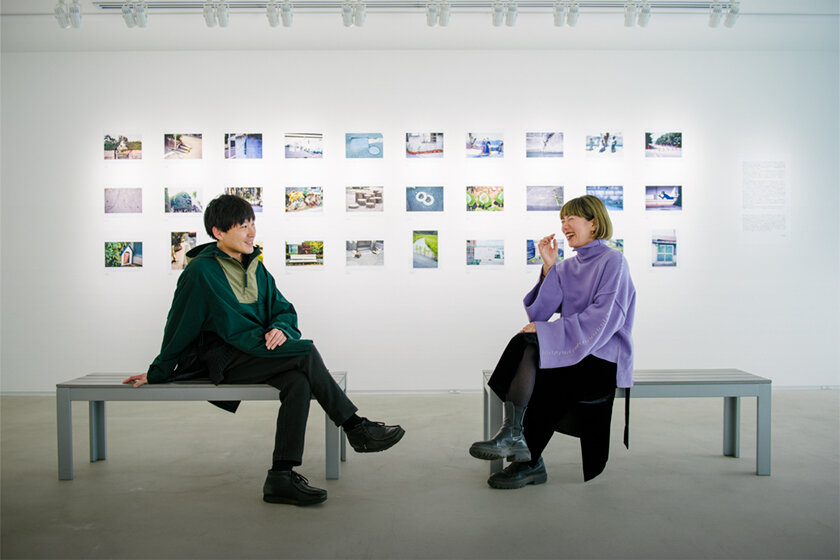
A "to the neighbor's for dinner" endeavor to generate intercommunication in segregated Roppongi
MohriIn getting to select Mr. Akasegawa's photos for the current exhibition (the Genpei Akasegawa photo exhibition Particles of Art Scattered in Daily Life), I thought the almost audacious way I immersed myself in his work, the way I said "excuse me" and stepped right inside his world was kind of like Yonesuke from Totsugeki! Tonari no Bangohan (Surprise! To the Neighbor's for Dinner--a reality TV show where the host Yonesuke invites himself into unsuspecting people's homes to see what they are eating for dinner .) [laughs]
HasunumaThat's a sudden throwback to the Showa Era that doesn't fit in with the Roppongi Future Talks. [laughs]
MohriBut wouldn't you want to try a "to the neighbor's for dinner" thing in Roppongi, actually? The only problem is that we're not famous enough for people to know who we are. If a stranger suddenly came to your house and said, "Show me your dinner," that would be a bit of a shock, wouldn't it?
HasunumaTrue. I feel like nowadays, life in the city is segregated. Capitalism has made people create thick walls between each other and live their separate lives. But if people were to pretend to be oblivious and show up at people's doorsteps asking to see their dinner, followed by an interaction where they get a sense of their usual lives and eating habits, I feel like that would diminish those walls of segregation a bit. I think the idea to do a "to the neighbor's for dinner" kind of thing in Roppongi actually has promise.
MohriI've always been incredibly interested in what people eat. Whenever I go to different regions in Japan or overseas, the first thing I ask is what people there eat, and what kinds of ingredients and dishes they recommend. I'm going to go to South Korea soon to set up an installation at the Gwangju Biennale, and I think I'll probably ask people, "So, what kind of things do you usually eat?" while pretending to engage in serious business talk.
Talking about food gives you an immediate sense for a city. And tableware varies by region as well, you know? Food, buildings, and tableware are so intimately linked together, and when I thought about how cultural these elements are, they suddenly felt so deep. I think they must be linked to old local paintings, sculpture, and architecture as well.
HasunumaTrue, even while our food, clothing, and housing have become increasingly westernized, about half of our food culture still seems intact. I'm a foodie as well, and I'm the same as Ms. Mohri in that "What's good to eat here?" is the first thing I ask when I go to a different region or overseas. I like it best when I deliberately have no information going in and ask a local when I get there. Every place has some person who is the go-to source of food information. Those people often have a kind of telltale quality or demeanor about them.
MohriI think demeanor is a big part of it. Foodies are generally eager to share their space with others, so they are often pretty social and adept at conversing beyond the topic of business.
HasunumaI guess food serves to link people together. Going back to what we were talking about, I think a "to the neighbor's for dinner" thing in Roppongi would be good in that sense as well. Because it's basically about trying to learn whether something tastes good or not, about learning how other people live by looking at what kind of tableware they use and what their eating etiquette is like. Different places have different cultures and lifestyles, and it's about trying to understand one another.
Everyone appears homogenous, even though they must all have different ideas
MohriDeepening mutual understanding is important too, but I also wish that everyone could be a bit more true to themselves and be free to indulge the ideas they have and the things they like. That way, we would get a better idea of society as every individual sees it. At the moment, everyone appears to be the same. We obviously all have different ideas, but even at the art university where I teach, I sometimes feel like everyone there only thinks about the things they're "supposed" to think about. More than half of the students in the department I'm in are students from overseas, and I get asked "Why is Japan like this?" a lot. For example, students have to submit a document in order to use an exhibition-prohibited location on campus as an exhibition space, or get permission to use electricity. These rules do function in a way to train students how to negotiate, but they also seem a bit like bureaucratic etiquette.
HasunumaTrue. While it can be necessary to follow rules, it's also important to enjoy figuring out how to find loopholes to deviate from the rules. I think we in particular tend to be adept at making our own rules like that. Being able to feel free to do things is something that needs to be developed gradually through experience, through successes and failures. So I wish things were a bit more flexible, so that people could be free to do things their own way, starting around preschool.
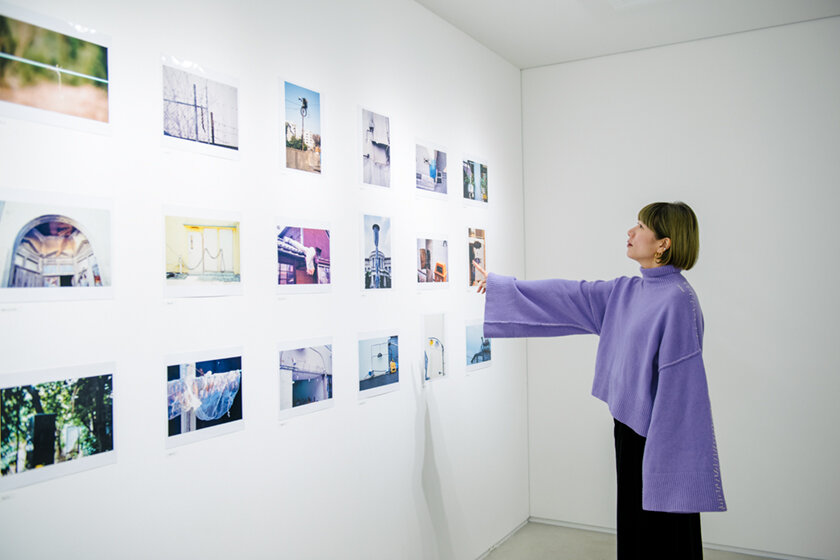
Beneficial "poison" is necessary at times to change society that's stuck in its ways
HasunumaUniversities included, any organization you might be a part of obviously has its own social culture, right? Societies can be very small-scale as well as large-scale. In the context of art, there's the social element of the market, as well as domestic and international differences in context and strategy. In terms of music, there's always the question of how musicians go about their work within a market-oriented structure.
If you take a step back from "art" and take a bigger-picture view as an active individual in society, capitalism has developed far too much in every unit of society that you're basically inserting content into a fully established system. I feel like the most you can do in that situation is to consider how to change the way the system works, or how to add in a foreign element that might shift the paradigm. But at the same time, I do think constructing society is stuck in its ways at the moment, and it's necessary to breathe new life into how that's done.
MohriI think you might need poison to do that. This is an example from before the COVID-19 pandemic, but I took some École des Beaux-Arts students with me to see the "Isamu Noguchi: from sculpture to body and garden exhibition"(2018) at Tokyo Opera City. Apparently, the exhibition was so inspiring that all of the students broke out dancing on the spot. I just stood there watching them, intrigued, until a staff member came to stop them even though they weren't actually doing anything morally wrong. But if they start off with a really small dance, maybe in a decade that might evolve into something really big, you know? The dancing is just one example, but what I want to say is that it would be nice to gradually spread that kind of "poison" to help develop immunity.
HasunumaLike getting society used to certain things gradually, over a long period of time.
Using artistic expression to convey a sense of freedom where everyone can deviate from society
MohriMaybe we could be that kind of poison. Hikaru Yamashita of the upcycled clothing brand Tochu de Yameru (Stop Halfway Through) sometimes makes posts on social media that say, "I just hid a hundred yen coin in so-and-so location. Feel free to look for it." I really like the idea of using that kind of guerrilla style of expression as poison. It would be even better if we could do away with the hierarchy of creator versus viewer and allow the freedom for artistic expression anywhere you want.
HasunumaThat's true. Just enjoying something all together for the sake of it is good too, but it's also important for each individual to newly discover or rediscover their own things and share it with others. In that sense, something guerrilla-like out on the streets that would allow open-minded discoveries might be good.
MohriIf we were to do something together in Roppongi? For example, you're about to release your new album symphil, but it might be interesting to do something collaborative where you could use your experience with music to do a live street performance and I could put up guerrilla artwork on the streets. I also wish there would be more places in cities where you were free to have picnics.
symphil
The first studio album in five years by the Shuta Hasunuma Philharmonic Orchestra project (released on March 22, 2023). The concepts of the album are "to treasure oneself and show affirmation for others and worlds outside of your own to live in harmony," "recovery," and "coexistence." The album cover illustration is by Johanna Tagada Hoffbeck, and its design is by Akira Sasaki. On April 2, the collective is scheduled to present its Music Today concert at the Tokyo Opera City Concert Hall: Takemitsu Memorial.
HasunumaPeople can eat stuff while listening to my performance and looking at your artwork.
MohriThat's right. Hanami (picnic with cherry blossoms) season is pretty much the only time people are free to party out in town. And it would be easy to do a "to the neighbor's for dinner" at a hanami. [laughs]
HasunumaYes. [laughs] I think this is particularly true of Japanese people, but there's this sense that you shouldn't ask people questions because we don't have phrases like "How are you?" that are designed for communicating with others. That's exactly why I think the "to the neighbor's for dinner" form of expression, where you pretend you're oblivious and invade other people's spaces is potentially a viable strategy.
MohriIt would also be fun if there were some kind of license that meant you didn't have to be famous to casually interview unsuspecting people. I wish I could deviate from society through that kind of expression. Being a YouTuber might be close to having that kind of license, but a lot of what they do is like a smaller-scale version of what a television personality does. Though we're talking about Totsugeki! Tonari no Bangohan so I suppose we're not that different. [laughs] Anyway, I just hope that our forms of expression might serve to be the "poison" that helps the city develop an immunity, in order to create a space where people are free to do what they want.
Photo location: Genpei Akasegawa Photos Particles of Art Scattered in Daily Life (venue: SCAI PIRAMIDE, January 26 to March 25, 2023)
Editor's thoughts
This interview wouldn't have been the same if Mr. Hasunuma and Ms. Mohri didn't know each other so well from before. The mood was amiable from start to finish with lots of laughter throughout. Their conversation was very genuine and simple in a good way, as if reflecting their personalities. In order to attain the freedom to do what we want, we need to take a step to deviate from the norm, take a step into obliviousness to break down the walls that segregate, and take a step towards regaining the human touch to overcome the ill effects of smartphone culture. Each is a bigger step than one would expect, but they're all steps that anyone can take. I think the way both artists express themselves gives people the courage and resolve to take that first step. I would also love to see a Roppongi version of "to the neighbor's for dinner"! I came out of this exhilarating interview with my heart feeling a bit lighter.(text_akiko miyaura)
RANKING
ALL
CATEGORY




